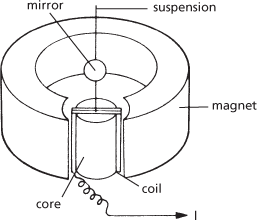An instrument for detecting and measuring small electric currents, invented by Luigi Galvani. In the moving-coil instrument a pivoted coil of fine insulated copper wire surrounds a fixed soft-iron core between the poles of a permanent magnet. The interaction between the field of the permanent magnet and the sides of the coil, produced when a current flows through it, causes a torque on the coil. The moving coil carries either a pointer or a mirror that deflects a light beam when it moves; the extent of the deflection is a measure of the strength of the current. The galvanometer can be converted into an ammeter or a voltmeter. Digital electronic instruments are increasingly replacing the moving-coil type. See also ballistic galvanometer.
An instrument that detects and measures small currents. One type of galvanometer is a moving-coil instrument (see diagram). This is designed so that the angular deflection of the small suspended coil is directly proportional to the current. The deflection may be observed by means of a light nonmagnetic pointer that moves over a scale or more usually by using a small mirror attached to the suspension. A beam of light is reflected by the mirror and the spot of light moves across a linear scale. This arrangement is sometimes called a mirror galvanometer. Greater sensitivity may be obtained by causing the reflected light spot to fall on a suitable photocell. This is known as a photoelectric galvanometer. The moving-coil galvanometer is virtually independent of the earth’s magnetic field, which is very weak compared to the field of the magnet.
Transient direct currents are measured using a ballistic galvanometer. Alternating currents of frequency less than a kilohertz can be detected and measured with a vibration galvanometer. This is usually a moving-coil instrument with light damping, which vibrates about the zero position when the current passes. Currents above a kilohertz can be measured with a thermocouple instrument.
Galvanometers measure small currents. Larger currents are measured using an ammeter. Most ammeters are shunted galvanometers: a resistor is connected in parallel with the galvanometer to reduce its sensitivity. The resistor is known as a galvanometer shunt.

Moving-coil galvanometer
http://www.sparkmuseum.com/GALV.HTM Photographs of some early galvanometers, from the Spark Museum of Electrical Invention
- lymphoid tissue
- lymphokine
- lymphoma
- lymphotoxin
- lynchet
- Lynch, Jack (1917–99)
- Lynen, Feodor
- Lynx
- lynx
- lyonium ion
- Lyons, Joseph Aloysius (1879–1939)
- lyophilic
- lyophilization
- lyophobic
- Lyotard, Jean-François (1924–98)
- Lyot, Bernard Ferdinand (1897–1952)
- Lyot filter
- lyotropic mesomorph
- Lyra
- Lyrid meteors
- Lysander (395)
- Lysenkoism
- Lysenko, Trofim Denisovich
- lysergic acid diethylamide
- lysigeny